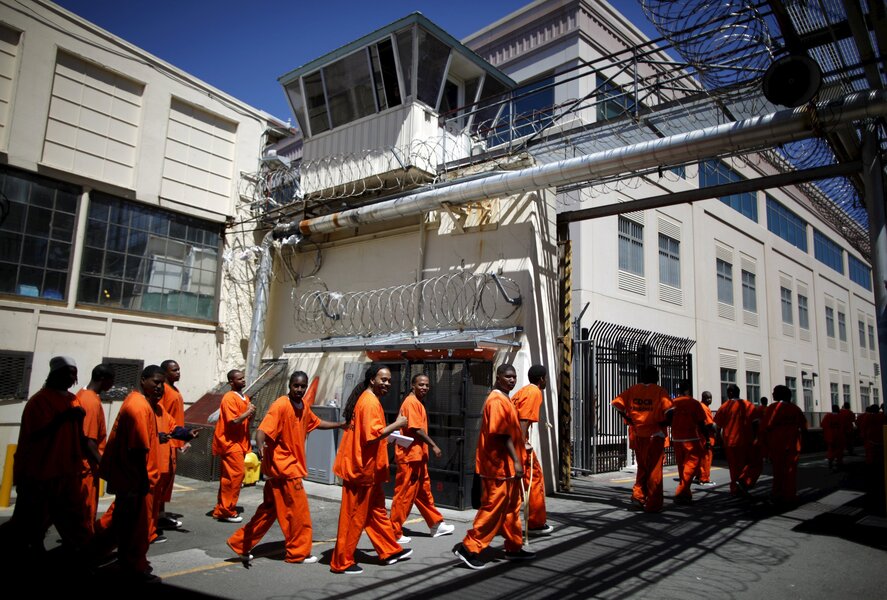Why some California inmates are turning to Shakespeare
Loading...
To prepare themselves for the outside world, some California inmates are performing Shakespeare plays.
The Arts in Corrections (AIC) program is made possible by a $3.5 million state grant, which is distributed through contracts with 10 different arts organizations to teach at 19 state prisons.
“I think that when inmates can prove they can do something as complicated, difficult and challenging as memorizing a whole Shakespeare play and performing it in front of their peers, not only is there a lot of personal transformation that’s going on, but also it transforms the institution,” Lesley Currier, director of the Marin Shakespeare Company, tells KXTV News in Sacramento, Calif.
Marin Shakespeare Company, serving “Region 3” in the San Francisco Bay area, will complete a year-long contract in June: 650 hours of AIC services compensated by $55,642. The company has been offering acting classes at San Quentin State Prison, located 12 miles north of the Golden Gate Bridge, since 2003 but last year marked Marin’s first year at Solano State Prison, located about 60 miles east of San Francisco.
“Shakespeare in prison was the point where I started to believe that a better breed of people cared about the existence of those of us incarcerated,” former Solano inmate Dameion Brown, who participated in the program during its inaugural year before being released after a 23-year sentence in August, tells CNN.
After his release, Mr. Brown stayed involved with the Marin Shakespeare Company, acting in a play on the company’s main stage.
But some victims’ families don’t see much value in spending state funds on acting classes for convicted killers.
“I’m afraid somebody is going to come along and feel sorry for him,” Karen Sousa, whose sister was killed by Marin student prisoner Christian Birdsall, tells CNN. “He is doing this to have people look at him as if he’s changed so he will be considered for parole. I don’t care how much yoga he takes, or Shakespeare, he’s not a man, he’s a psychopath.”
But AIC might help California with a serious problem: recidivism.
According to a 2013 Outcome Evaluation Report by the California Department of Corrections and Rehabilitation, three-year recidivism rates for adult prisons has stayed above 60 percent since the turn of the century. But nationally, 49.3 percent of prisoners are rearrested within eight years of release. In other words, inmates in California are far more likely to end up back in prison within a few years.
“It is impossible to consider national trends in corrections and recidivism without accounting for the oversized impact the state of California has on these trends,” says the National Reentry Resource Center, because the state’s “high recidivism rates skewed national recidivism data....”
California has many reasons to want to lose its recidivism reputation, one being fiscal. When the state’s recidivism rate was close to 70 percent at the beginning of the 21st century it cost $1 billion per year. So while $4 million may seem like a lot of money to spend on art classes for inmates, it costs only 0.004 percent of total recidivism costs.
Others say the program can help inmates develop job skills, especially in California. AIC’s most recent report found that 1 out of every 10 jobs in California is in a “creative industry.”
“To be an actor, you have to communicate, you have to work with others, you have to create and imagine – all that stuff,” Michael Bierman, an acting instructor at the Los Angeles County state prison, told People magazine in January. “They’re learning skills for any job.”
One of these skills includes learning how to peaceful interact with different races and cultures.
“I don’t want to be closed in with prison life. When I get out, my co-workers might be white or Mexican and we’re gonna end up working next to each other – we can start that in here,” inmate James Frierson told People. “It’s alright to interact with other races; we’re showing it’s okay. Be yourself, make friends, change your life so that when you go back to society, you’ll be better at dealing with yourself.”
Gov. Jerry Brown allocated $4 million to Arts in Corrections next year, expanding the program to all 34 state prisons.








